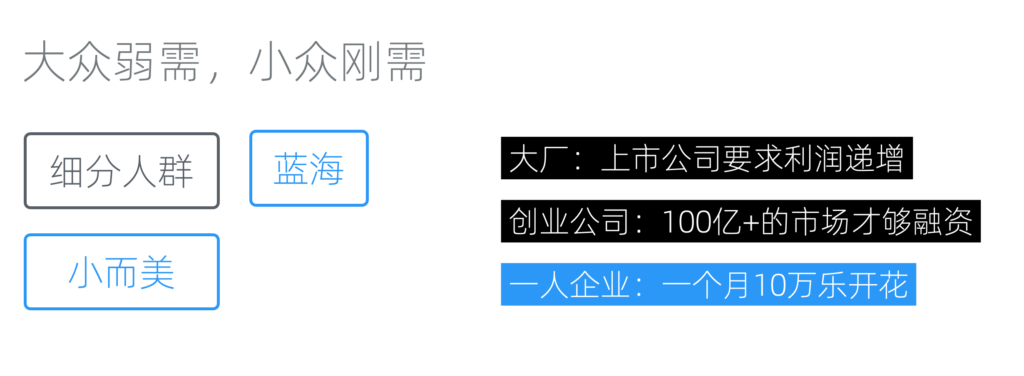Now let's discuss the second part of "Planning a One-Person Business", the track selection.
The first thing I want to share with everyone is a somewhat counterintuitive viewpoint — stay away from the mass market's rigid needs. This is somewhat different from the methodologies we usually encounter. Whether it's a large company or a startup, product planning often emphasizes the necessity to meet the rigid needs of the masses, because only in this way can a sufficiently large market be covered, thus obtaining corresponding returns.
This choice may be taken for granted by large companies and startups, as large companies have the dual leverage of manpower and capital, while startups rely on capital leverage. However, for a one-person business, if the same logic is used to choose a track, it will undoubtedly directly collide with large companies and startups, leading to direct competition, which is clearly not what we desire.

Public Demand: A Crowded and Easily Trampled Track
For a one-person business, at least in the initial stage, directly targeting the mass market's essential needs is not a good strategy. This is because it means we will be directly facing powerful competitors who have human and capital leverage. It is not to say that we cannot win at all, but there is no need to unnecessarily increase the difficulty of the competition.
On the contrary, we can choose to start from those places where the demand is weak for the general public, but strong for certain niche groups. I call this niche necessity.
Taking nutritional meal planning as an example, for the general public, this may be a weak demand, as occasional nutritional deficiencies and excesses are not their primary concern; most people pay more attention to the taste of food. However, for mothers and infants, nutrition is their primary focus, a rigid demand, far more important than taste.

The weak demand of the masses may be the strong demand of a niche.
Through such strategies, we can find a segment of the market that is actually a rigid demand within the weak demand of the public, which is precisely what a one-person business should focus on. If you find that this segment is still full of competition, you can further subdivide it. The advantage of a one-person business is that, even if this market is very small, it is often sufficient for a one-person business.

A one-person business can choose a more niche market.
However, although we may find various niche demands, whether they are suitable for us depends on whether we can gather or reach this segmented group in a cost-effective manner.
Because one major issue with niche markets is that the cost-effectiveness of general customer acquisition methods is extremely low. For example, spending several million on a splash screen advertisement for a mass-market fast-moving consumer product, if 1 million people see it, among them, 800,000 are potential target users, and the final clicks might be 200,000. However, if a niche product is advertised at the same price, among 1 million people, it is very likely that only 100,000 are target users, resulting in very low final clicks and conversions.
Some niche groups have their own vertical channels, such as forums. But the problem with these channels is that the user limit is very low, and often after a few placements, the users are fully covered. Many vertical communities also have a natural aversion to advertising. On the other hand, the uneven quality of small channels also makes placement more difficult.
Of course, the above discussion is about situations where there are market costs. A more common situation is that there is no market budget at all. At this time, we need to do the work of gathering niche groups ourselves. Common methods include the following:
- Content Marketing: Gather users through writing articles and posting videos in a self-media way
- SEO: Obtain users through search engines relying on specific keyword groups
- Side Project Marketing: Develop a (free) project specifically for acquiring customers and spreading information based on the special needs of niche groups
The first two should be familiar to everyone, so I won't elaborate. Let's talk about SideProject marketing. Content marketing often has a low threshold and is easy to replicate, which is usually not scarce for niche markets, but the threshold for SideProject is a bit higher, and the value it provides to users is also more unique, making it easier to acquire customers and spread. Continuing with the example of the maternal and infant population above, after browsing forums and conducting user interviews, we can create a SideProject that has demand but is unmet, such as a breastfeeding management APP (random example, not necessarily in demand) to acquire customers.
It can be seen that whether one can access and concentrate on niche markets at a low cost mainly depends on individual resources and capabilities, and is often a long-term process.
Therefore, we recommend choosing your own "area of expertise" as much as possible. If you are passionate about a certain field, you can continue to invest even in situations where the returns are low or even zero; this is what is called an area of expertise.
We have compiled hundreds of historical reports from Trends.vc hundreds of historical reports and summarized the following tracks/trends suitable for one-person businesses, hoping to inspire everyone:
- Software as a Service (SaaS): SaaS templates, AI-driven SaaS, WordPress plugins, Shopify plugins, Chrome extensions, enterprise SaaS, micro SaaS.
- Digital Content Creation: YouTube channels, non-appearance YouTube channels, short videos, podcasts, AI image generators, AI-generated content.
- Education and Learning: Micro education (such as SMS-based) businesses, online courses, group-based (user grouping) courses.
- Content Marketing: Non-appearance social media accounts, daily Newsletter, paid Newsletter, SideProject marketing.
- Community and Network: Paid community, Token-based community.
- Growth Strategy: Growth hacking, categorized navigation services, crowdsourcing, marketing funnel, product-oriented growth.
- Individual Entrepreneurship: Build a million-dollar one-person business through high-leverage skills, personal branding, micro-monopolies (independent categories), diversified income, and trust monetization.
- Micro Enterprises and Investment: Micro private equity, angel investment.
- Monetization Models: Decentralized Autonomous Organizations (DAOs), Non-Fungible Tokens (NFTs), Decentralized Finance (DeFi).
- Artificial Intelligence and Machine Learning: Segmented AI models, open-source AI, AI-generated music, AI agents, prompt engineering, voice cloning.
- No-Code/Low-Code Development: No-code, low-code.
- Blockchain and Digital Currency: Liquidity mining, non-fungible tokens (NFTs), decentralized finance (DeFi).
- Professional Services and Consulting: Including agency services, software development services, consulting, micro-consulting.
- Customized Products and Services: Including unlimited services, mobile applications, e-books, independent games.
Note: Due to policy restrictions, digital currency-related businesses are prohibited in mainland China.